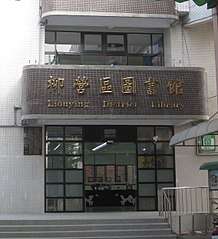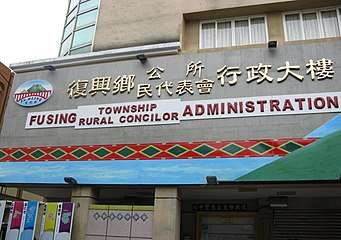Tongyong Pinyin
Tongyong Pinyin (Chinese: 通用拼音; Hanyu Pinyin: Tōngyòng Pīnyīn; Tongyong Pinyin: Tongyòng Pinyin; lit.: 'general-use spelling of sounds') was the official romanization of Mandarin in Taiwan between 2002 and 2008. The system was unofficially used between 2000 and 2002, when a new romanization system for Taiwan was being evaluated for adoption. Taiwan's Ministry of Education approved the system in 2002,[1][2] but its use was optional. Since January 1, 2009, the Ministry of Education has officially promoted Hanyu Pinyin (per decision on September 16, 2008); local governments would "not be able to get financial aid from the central government" if they used Tongyong Pinyin-derived romanizations.[3][4] After this policy change, Tongyong Pinyin has been used for the transliteration of some place names and personal names in Taiwan (Republic of China).[5] Some of the romanized names of the districts, subway stations[6] and streets[7][8] in Kaohsiung[9], Tainan[10], Taichung[11], Yunlin County[12] and other places[13][14][15] are derived from Tongyong Pinyin- for example, Cijin District (旗津區, Cíjin Cyu).[16]
| Chinese romanization |
|---|
| Mandarin |
|
Sichuanese |
| Wu |
| Yue |
| Min |
| Gan |
|
Chang-Du dialect |
| Hakka |
| Xiang |
|
Chang–Yi dialects |
| See also |
|
Other transliterations |
History

The impetus behind the invention of Tongyong Pinyin came from the need for a standardized romanization system in Taiwan. For decades, the island had employed various systems, usually simplifications or adaptations of Wade–Giles. (Zhuyin, a standard phonetic system for language education in Taiwan's schools, does not use the Latin alphabet.)
Tongyong Pinyin was introduced in 1998 by Yu Bor-chuan to preserve the strengths of Hanyu Pinyin while eliminating some of the pronunciation difficulties Hanyu presents to international readers, such as difficulties with the letters q and x. Yu's system was subsequently revised.
Discussion and adoption of Tongyong Pinyin, like many other initiatives in Taiwan, quickly acquired a partisan tone turning on issues of national identity: Chinese vs. Taiwanese identity.[17] Officials who identified most strongly with the nation itself, such as the Democratic Progressive Party (DPP) and its allied parties, saw no reason to adopt Hanyu Pinyin just because Mainland China and the UN had. If Tongyong Pinyin more adequately met the nation's needs, they saw this as ample justification for Taiwan to adopt it.[18] Officials who identified more strongly with Chinese culture, such as the Kuomintang (KMT), saw no reason to introduce a new system unique to Taiwan if Hanyu Pinyin had already gained international acceptance. Each side accused the other of basing its preference on anti-China or pro-China sentiment rather than an objective discussion of community goals.[19]
In early October 2000, the Mandarin Commission of the Ministry of Education proposed to use Tongyong Pinyin as the national standard. Education Minister Ovid Tzeng submitted a draft of the Taiwanese romanization in late October to the Executive Yuan, but the proposal was rejected. In November 2000, Tzeng unsuccessfully suggested that the government adopt Hanyu Pinyin with some modifications for local dialects. On 10 July 2002, Taiwan's Ministry of Education held a meeting for 27 members. Only 13 attended. Two left early, and since the chairman could not vote, the bill for using Tongyong Pinyin was passed with 10 votes.[1]
In August 2002 the government adopted Tongyong Pinyin by an administrative order that local governments had the authority to override within their jurisdiction. In October 2007, with the DPP administration still in power, it was announced that Taiwan would standardize the English transliterations of its Chinese Mandarin place names by the end of the year, after years of confusion from multiple spellings, by using the locally developed Tongyong Pinyin.[20]
In 2008, the Kuomintang won both the legislative and presidential elections. In September 2008, it was announced that Tongyong Pinyin would be replaced by Hanyu Pinyin as Taiwan's standard, at the end of the year. Since January 1, 2009, Hanyu Pinyin has been an official romanization system in Taiwan.[3][4]
.jpg)
Adoption and use
Tongyong Pinyin was the official romanization system in Taiwan, but its use was voluntary.[21] The romanization system that one encounters in Taiwan varies according to the government authority that administers the facility. Street signs in most areas use Tongyong Pinyin, including the cities of Kaohsiung, Tainan, and surrounding counties. A contrast could be seen in the two entities that now make up the municipality of Taichung—Taichung County used Tongyong Pinyin while Taichung City has used Hanyu Pinyin since at least 2004. Then-mayor Ma Ying-jeou remained committed to using Hanyu Pinyin as the Romanization standard for Taipei.[22] Taipei County (now New Taipei City) used Tongyong Pinyin, but in Taipei Metro stations, Tongyong Pinyin was given in parentheses after Hanyu Pinyin. Modified Wade–Giles spellings are popularly used for many proper names, especially personal names and businesses.
The political impasse prevented Ministry of Education from being able to replace Zhuyin in teaching pronunciation in elementary school. Zhuyin is widely used to teach Mandarin pronunciation to schoolchildren. Children's books published in Taiwan typically display Zhuyin characters next to Chinese characters in the text.
On September 17, 2008, the Ministry of Education announced that the government standard for romanization would be switched to Hanyu Pinyin nationwide, effective January 1, 2009.[3][4] However, people in the Taiwan( Republic of China) can freely choose their foreign language names. So although Tongyong Pinyin was effectively scrapped as the romanization standard of Taiwan's central government, many today choose a romanized form of their Chinese character name which is created based on the Tongyong Pinyin, Wade-Giles, or Yale romanization systems.[23]
Today, districts of Kaohsiung are named by Tongyong. Districts of Tainan are mostly named by Tongyong with exceptions such as Xinying.
Taiwanese language variant
The Tongyong Pinyin system also exists in a Taiwanese Hokkien phonetic symbol version, Daighi tongiong pingim, which lacks f but adds bh. However, in 2006, the Ministry of Education rejected the use of Daighi tongiong pingim for the Taiwanese dialect and preferred the Taiwanese Romanization System.[24]
Features
Spelling
Some notable features of Tongyong Pinyin are these:
- The first tone is unmarked.
- Hanyu Pinyin's zh- becomes jh- (Wade–Giles uses ch-).
- Hanyu Pinyin's x- and q- are not used in Tongyong Pinyin and become s- and c- (Wade–Giles uses hs- and ch'-).
- The Hanyu Pinyin -i (not represented in Zhuyin) known as the empty rhyme (空韻), are shown as -ih (somewhat like Wade–Giles): those in Hanyu Pinyin as zi (資), ci (慈), si (思), zhi (知), chi (吃), shi (詩), and ri (日) all end in -ih in Tongyong Pinyin.
- ü used in Hanyu Pinyin (written u after j, q and x) is replaced by yu.
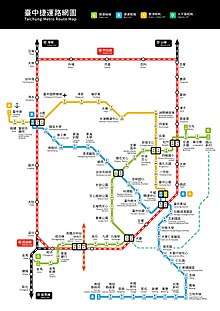
- -eng becomes ong after f- and w- (奉、瓮)
- wen (溫) becomes wun
- -iong becomes yong: syong instead of pinyin xiong (兇) (cf. -iang remains unchanged: siang).
- Unlike in Wade–Giles and Hanyu Pinyin, -iu and -ui (liu [六] and gui [鬼]), contractions can be written out in full as -iou and -uei. However, according to the Ministry of the Interior, in romanizations of names of places that is at township-level or below township-level, the letters must be written in full.
Punctuation
- Tongyong syllables in the same word (except placenames) are to be separated by hyphens, like Wade–Giles, but in the Ministry of the Interior's romanizations, placenames have no spaces between the syllables.
- Tongyong uses tone marks like Zhuyin, not like Hanyu Pinyin. Tongyong Pinyin has no mark for the first tone but a dot for the neutral tone (optional on computers).
- The optional syllable disambiguation mark is apostrophe (like Hanyu Pinyin): ji'nan vs. jin'an. The mark may also, as in the Ministry of the Interior placenames, be a hyphen.
Shared features with Hanyu Pinyin
If tone is ignored, 19.47% of Tongyong Pinyin syllables are spelled differently to those of Hanyu Pinyin. The difference widens when syllables are measured according to average frequency of use in everyday life to a 48.84% difference in spellings.[25] In two cases (si and ci) the same Latin spelling denotes different syllables depending on the transcription system.
Arguments
The prevalence of Hanyu Pinyin as an established system weighs at least as heavily on the debate over Tongyong Pinyin as any feature of the system itself. Arguments presented in the ongoing debate include these.
Supporting Tongyong Pinyin
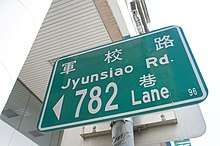
Intrinsic
- Tongyong spelling, it is argued, yields more accurate pronunciation from non-Chinese speakers than does Hanyu Pinyin. Tongyong does not use the letters q and x, for example, in ways that confuse non-Chinese speakers who lack training in the system.[26] However, this argument is contradicted by internal inconsistencies in Tongyong Pinyin (for example, in the use of the letter "c" in Tongyong Pinyin to represent the sound tɕʰ, represented by "q" in Hanyu Pinyin). Such a pronunciation would require the same amount of familiarization as Hanyu Pinyin.
- Those familiar with Hanyu Pinyin will encounter nothing radically different when using Tongyong Pinyin.
- Tongyong eliminates the need for diacritics for the umlauted-u sound.
- The spellings "fong" and "wong" are more accurate to reflect the sounds of 風 and 翁, as pronounced in the Standard Mandarin in Taiwan, as compared with "feng" and "weng".
Practical
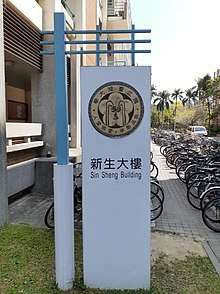
- Tongyong Pinyin is business-friendly because of the ease it offers in pronunciation. Visitors to Taiwan can thus more easily describe and find place names, personal names, businesses and locales.
- Tongyong Pinyin requires no more special accommodation in international correspondence than the difference in Chinese characters (simplified vs. traditional) already requires.
- Tongyong strikes a balance between the need for internationalization and Taiwan's local needs.[27]
- Tongyong Pinyin would not supplant Hanyu Pinyin in Taiwan, as Hanyu Pinyin is rarely encountered outside the Taipei area anyway and has never been in common use. Tongyong Pinyin is intended to supplant the many variants of Wade–Giles that remain the dominant form of romanization encountered in Taiwan. No one questions the superiority of Tongyong Pinyin to Wade–Giles and the benefit to be gained from the change.
- Tongyong does not force its exclusive use on those who have already studied Hanyu Pinyin. One can use any system to render characters while one types or formats documents in Mandarin. Computers and electronic devices in Taiwan already offer Hanyu Pinyin and MPS keyboards as options. Transitions between romanized forms are also easily achieved if needed.
- Romanization is most useful to individuals who lack training in Mandarin but encounter names and terms in press reports and literature. Students of Mandarin gain literacy in Chinese characters and drop romanization systems of any kind. It, therefore, makes sense that, if possible, one should enable a confident first-time pronunciation of Mandarin words by outsiders.
Against Tongyong Pinyin
Intrinsic
- Tongyong Pinyin treats c and s as having two allophones each:
- c is pronounced [tɕʰ] before "i", and [tsʰ] otherwise
- s is pronounced [ɕ] before "i", and [s] otherwise
- Internal inconsistencies exist within Tongyong Pinyin such as the use of different letters to represent the same sound: e vs. u (ben, pen, fen and men but wun) and i vs. y (ciang but cyong, ㄑㄧㄤ, ㄑㄩㄥ) because of the correspondence with the equivalent Zhuyin spellings or the use of the same letter to represent different sounds (s, c and z, each representing both a dental and a palatal sibilant). Such inconsistencies are more numerous than those found in Hanyu Pinyin.
Practical
- The standard romanization system of Mainland China, the International Organization for Standardization, and the United Nations is Hanyu Pinyin.[28]
- Tongyong Pinyin-derived transliteration spellings are created. For example, "Qing Dynasty" (via Hanyu Pinyin) and "Ch'ing Dynasty" (via Wade–Giles) is spelled as "Cing Dynasty" (via Tongyong Pinyin). "Zhou Dynasty" (via Hanyu Pinyin), or "Chou Dynasty" (via Wade–Giles), is spelled as "Jhou Dynasty" (via Tongyong Pinyin).
Comparison with other orthographies
The differences between Tongyong Pinyin and Hanyu Pinyin[29] are relatively straightforward:
- The palatalized consonants are written j, c, s rather than j, q, x
- The retroflex consonants are jh, ch, sh rather than zh, ch, sh
- The "buzzing" vowels are written ih (shih, sih) rather than i (shi, si)
- Yu and yong are still spelled with a 'y' even after a consonant (nyu, jyong), rather than as ü, u, or iong
- You and wei are written iou and uei after a consonant (diou, duei), rather than contracted to iu and ui
- Eng is written labialized ong after the labial consonants f, w (fong, wong), but weng/wong contracts to ong after another consonant in both systems
- Wen becomes wun
- Neutral tone is written but not first tone
| IPA | a | ɔ | ɛ | ɤ | ai | ei | au | ou | an | ən | aŋ | əŋ | ʊŋ | aɚ |
|---|---|---|---|---|---|---|---|---|---|---|---|---|---|---|
| Pinyin | a | o | ê | e | ai | ei | ao | ou | an | en | ang | eng | ong | er |
| Tongyong Pinyin | e | e | ||||||||||||
| Wade–Giles | eh | ê/o | ên | êng | ung | êrh | ||||||||
| Bopomofo | ㄚ | ㄛ | ㄝ | ㄜ | ㄞ | ㄟ | ㄠ | ㄡ | ㄢ | ㄣ | ㄤ | ㄥ | ㄨㄥ | ㄦ |
| example | 阿 | 哦 | 呗/唄 | 俄 | 艾 | 黑 | 凹 | 偶 | 安 | 恩 | 昂 | 冷 | 中 | 二 |
| IPA | i | je | jou | jɛn | in | iŋ | jʊŋ | u | wo | wei | wən | wəŋ | y | ɥe | ɥɛn | yn |
|---|---|---|---|---|---|---|---|---|---|---|---|---|---|---|---|---|
| Pinyin | yi | ye | you | yan | yin | ying | yong | wu | wo/o | wei | wen | weng | yu | yue | yuan | yun |
| Tongyong Pinyin | wun | wong | ||||||||||||||
| Wade–Giles | i/yi | yeh | yu | yen | yung | wên | wêng | yü | yüeh | yüan | yün | |||||
| Bopomofo | ㄧ | ㄧㄝ | ㄧㄡ | ㄧㄢ | ㄧㄣ | ㄧㄥ | ㄩㄥ | ㄨ | ㄨㄛ/ㄛ | ㄨㄟ | ㄨㄣ | ㄨㄥ | ㄩ | ㄩㄝ | ㄩㄢ | ㄩㄣ |
| example | 一 | 也 | 又 | 言 | 音 | 英 | 用 | 五 | 我 | 位 | 文 | 翁 | 玉 | 月 | 元 | 云/雲 |
| IPA | p | pʰ | m | fəŋ | tjou | twei | twən | tʰɤ | ny | ly | kɤɚ | kʰɤ | xɤ |
|---|---|---|---|---|---|---|---|---|---|---|---|---|---|
| Pinyin | b | p | m | feng | diu | dui | dun | te | nü | lü | ger | ke | he |
| Tongyong Pinyin | fong | diou | duei | nyu | lyu | ||||||||
| Wade–Giles | p | pʻ | fêng | tiu | tui | tun | tʻê | nü | lü | kor | kʻo | ho | |
| Bopomofo | ㄅ | ㄆ | ㄇ | ㄈㄥ | ㄉㄧㄡ | ㄉㄨㄟ | ㄉㄨㄣ | ㄊㄜ | ㄋㄩ | ㄌㄩ | ㄍㄜㄦ | ㄎㄜ | ㄏㄜ |
| example | 玻 | 婆 | 末 | 封 | 丟 | 兑/兌 | 顿/頓 | 特 | 女 | 旅 | 歌儿/歌兒 | 可 | 何 |
| IPA | tɕjɛn | tɕjʊŋ | tɕʰin | ɕɥɛn | ʈʂɤ | ʈʂɨ | ʈʂʰɤ | ʈʂʰɨ | ʂɤ | ʂɨ | ɻɤ | ɻɨ | tsɤ | tswo | tsɨ | tsʰɤ | tsʰɨ | sɤ | sɨ |
|---|---|---|---|---|---|---|---|---|---|---|---|---|---|---|---|---|---|---|---|
| Pinyin | jian | jiong | qin | xuan | zhe | zhi | che | chi | she | shi | re | ri | ze | zuo | zi | ce | ci | se | si |
| Tongyong Pinyin | jyong | cin | syuan | jhe | jhih | chih | shih | rih | zih | cih | sih | ||||||||
| Wade–Giles | chien | chiung | chʻin | hsüan | chê | chih | chʻê | chʻih | shê | shih | jê | jih | tsê | tso | tzŭ | tsʻê | tzʻŭ | sê | ssŭ |
| Bopomofo | ㄐㄧㄢ | ㄐㄩㄥ | ㄑㄧㄣ | ㄒㄩㄢ | ㄓㄜ | ㄓ | ㄔㄜ | ㄔ | ㄕㄜ | ㄕ | ㄖㄜ | ㄖ | ㄗㄜ | ㄗㄨㄛ | ㄗ | ㄘㄜ | ㄘ | ㄙㄜ | ㄙ |
| example | 件 | 窘 | 秦 | 宣 | 哲 | 之 | 扯 | 赤 | 社 | 是 | 惹 | 日 | 仄 | 左 | 字 | 策 | 次 | 色 | 斯 |
| IPA | ma˥˥ | ma˧˥ | ma˨˩˦ | ma˥˩ | ma |
|---|---|---|---|---|---|
| Pinyin | mā | má | mǎ | mà | ma |
| Tongyong Pinyin | ma | må | |||
| Wade–Giles | ma1 | ma2 | ma3 | ma4 | ma |
| Bopomofo | ㄇㄚ | ㄇㄚˊ | ㄇㄚˇ | ㄇㄚˋ | ˙ㄇㄚ |
| example (Chinese characters) | 妈/媽 | 麻 | 马/馬 | 骂/罵 | 吗/嗎 |
Gallery
See also
- Hanyu Pinyin
- Daighi tongiong pingim (DT in Taiwanese; 閩南語通用拼音)
References
- "Tongyong Pinyin the new system for romanization". Taipei Times. 11 July 2002. p. 3.
- "Taiwan Authority Concerned Passes Tongyong Pinyin Scheme". People's Daily Online. 12 July 2002.
- Shih Hsiu-Chuan (18 Sep 2008). "Hanyu Pinyin to be standard system in 2009". Taipei Times. p. 2.
- "Gov't to improve English-friendly environment". The China Post. 18 September 2008. Archived from the original on 19 September 2008.
But local governments will not be able to get financial aid from the central government if they insist on using the provincial Tongyong Pinyin system for all new street signs, documents, tourist maps, and other things related to Chinese romanization.
- "NOTICE TO READERS". Taipei Times. 25 August 2009. Retrieved 14 July 2019.
To reflect general acceptance of the Tongyong Pinyin system by local governments, from today, Taipei Times will adopt this as the default Romanization system for place names in Taiwan. Exceptions apply for Taipei City, for which the Hanyu Pinyin system applies; city and county names whose traditional spelling has been retained (e.g., Kaohsiung, Keelung, Hsinchu); and localities with commonly accepted variations (e.g. Tamsui).
- Liu Chien-kuo, Chen Ting-fei, Kuan Bi-ling, Cheng Pao-chin (18 January 2017). "Language: A tool for messages or identity". Taipei Times. Retrieved 29 July 2019.
Since Taiwan’s Tongyong pinyin is closer to how English is actually pronounced and spoken around the world, — it uses “si” instead of “xi” — the new MRT line should use Tongyong pinyin. Kaohsiung’s MRT has used Tongyong pinyin for many years, yet foreign visitors and residents have no problem navigating the system.
CS1 maint: uses authors parameter (link) - 劉婉君 (15 October 2018). 路牌改通用拼音? 南市府:已採用多年. Liberty Times (in Chinese). Retrieved 28 July 2019.
基進黨台南市東區市議員參選人李宗霖今天指出,台南市路名牌拼音未統一、音譯錯誤等,建議統一採用通用拼音。對此,台南市政府交通局回應,南市已實施通用拼音多年,將全面檢視路名牌,依現行音譯方式進行校對改善。
- Eryk Smith (27 November 2017). "OPINION: Hanyu Pinyin Should Not Be Political, Kaohsiung". Retrieved 13 July 2019.
why does Kaohsiung City insist on making visitors guess what 'Shihcyuan' is supposed to represent? Especially when a few blocks away, the same road has somehow morphed into 'Shiquan' (十全路) Road? Move away from Kaohsiung's city center and streets, neighborhoods or townships can have several romanized names ... sometimes on the same signage.{...}The refusal to adopt Hanyu in Kaohsiung seems based on nothing more than groundless fear of loss of identity or diminished regional autonomy. Listen, Kaohsiung: we won't lose our identity or our freedom by changing the romanized spelling of Singjhong Road (興中)to Xingzhong.
- "Administrative Districts". Kaohsiung City Government. Retrieved 26 April 2019.
Taoyuan District Maolin District Namasia District Jiasian District Liouguei District Shanlin District Meinong District Neimen District Cishan District Dashu District Daliao District Zihguan District Linyuan District Tianliao District Yanchao District Dashe District Renwu District Siaogang District Fongshan District Mituo District Alian District Gangshan District Niaosong District Ciaotou District Nanzih District Zuoying District Gushan District Sanmin District Sinsing District Cianjin District YanCheng District Lingya District Cijin District Cianjhen District Hunei District Lujhu District Cheting District Yongan District
- "District Office". Tainan City Government Global Website. 2016-06-03. Retrieved 23 July 2019.
Eastern District Office North District Office West Central District Office South District Office Anping District Office Annan District Office Sinying District Office Yanshuei District Office Baihe District Office Liouying District Office Houbi District Office Dongshan District Office Madou District Office Xiaying District Office Lioujia District Office Guantian District Office Danei District Office Jiali District Office Syuejia District Office Sigang District Office Cigu District Office Jiangjyun District Office Beimen District Office Sinhua District Office Shanhua District Office Sinshih District Office Shanshang District Office Yujing District Office Nansi District Office Nanhua District Office Zuojhen District Office Rende District Office Gueiren District Office Guanmiao District Office Longci District Office Yong Kang District Office Anding District Office
- 喻文玟 (15 June 2019). 漢語拼音vs.通用拼音 中市捷運、街道不同調. 聯合新聞網 (in Chinese). Retrieved 28 July 2019.
台中捷運綠線明年底通車,目前18站有命名爭議,捷運迷也發現,車站名稱的英文拼音「一市兩制」,台中的道路採「漢語拼音」,捷運站是用「通用拼音」,以主要幹道文心路為例,路牌是漢語拼音「wenxin」;捷運站是通用拼音「wunsin」。
- "Village, Township and City offices". 雲林縣政府 YUNLIN COUNTY GOVERNMENT. 24 September 2019. Retrieved 27 March 2020.
Title PostDate Shueilin Township{...}Linnei Township{...}Kouhu Township{...}Cihtong Township{...}Sihhu Township{...}Dapi Township{...}Yuanchang Township{...}Gukeng Township{...}Taisi Township{...}Beigang Township{...}Baojhong Township{...}Tuku Township{...}Dongshih Township{...}Siluo Township{...}Mailiao Township{...}Huwei Township{...}Lunbei Township{...}Dounan Township{...}Erlun Township{...}Douliou City{...}
- "Information". Zhongshan District Office, Keelung City. Retrieved 28 September 2019.
Wunhua Rd. Fusing Rd. Fusing Rd.
- "bg01". 基隆市信義區公所 (in Chinese and English). Retrieved 28 September 2019.
基隆市信義區公所 Keelung City Sinyi District Office
- "Introduction". Sinyi District Household Registration Office, Keelung. Retrieved 28 September 2019.
Subordinated to Keelung City Government, Sinyi District Household Registration Office is located in the center of Keelung City. The current district area is 10.670 sq. km., including 20 villages and 412 neighborhoods in total. Since lots of government institutions are set here and a great proportion of the residents are government officials, Sinyi District is also called ¡§educational and cultural district.¡¨ It is adjacent to Jhongjheng District in the east and north, Renai District in the south, Rueifang District, New Taipei City in the South-east.
- "History". Cijin District Office,Kaohsiung City. Retrieved 13 July 2019.
Cijin district
- Hsu Wen-lian (19 Jul 2002). "Rush to Tongyong Pinyin reckless". Taipei Times. p. 8.
- Lin Mei-chun (17 July 2002). "Minister to play down Tongyong controversy". Taipei Times. p. 3.
- "Hanyu, Tongyong: survival of the fittest?". The China Post. 2 January 2007.
- "Taiwan to standardize English spellings of place names". International Herald Tribune. 27 October 2007.
- Ko Shu-ling (5 Oct 2002). "Tide of Romanization could shift". Taipei Times. p. 2.
- Huang, Sandy (3 Aug 2002). "Ma remains Tongyong Pinyin holdout". Taipei Times. p. 2.
Despite the central government's decision to make Tongyong Pinyin the official system for the Roman-ization of street signs, Taipei City Mayor Ma Ying-jeou (馬英九) yesterday remained firm in his stand that the Taipei City Government would continue using Hanyu Pinyin as its Romanization standard.
- Martin Boyle (22 January 2017). "Pinyin and a Taiwanese identity". Retrieved 14 July 2019.
Taiwan has held on to traditional characters and bopomofo, resolutely resisted simplified characters, mostly retained Wade-Giles and Yale for personal, political and geographical names in Taiwan, but grudgingly accepted the linguistic arguments for Hanyu pinyin signage in public spaces.
- Swofford, Mark (2 October 2006). "MOE approves Taiwanese romanization; Tongyongists protest". Retrieved 2008-09-20.
- Tsai, Chih-Hao (1 July 2004). "Similarities Between Tongyong Pinyin and Hanyu Pinyin: Comparisons at the Syllable and Word Levels". Retrieved 2008-09-20.
- Hong, Charles (15 November 2004). "Promote Tongyong Pinyin". Retrieved 2008-09-20. (This argument needs a credible reference, as current reference is to a letter to a newspaper by a non-expert. To refute such a statement it might be argued that it is an Anglocentrism because the value of Hanyu Pinyin x, for instance, would not be surprising for Portuguese speakers and users of Portuguese-influenced alphabets such as Vietnamese.)
- Hwang Hsuan-fan; Chiang Wen-yu; Lo Seo-gim; Cheng Liang-wei (9 January 2000). "Romanization must strike a balance". Archived from the original on 22 November 2011. Retrieved 2008-09-20.
- "Taipei Times". www.taipeitimes.com.
- "Tongyong Pinyin romanization system for Mandarin Chinese". Pinyin.info. Retrieved 13 July 2019.
External links
- Linguistic analysis
- Bopomofo-Hanyu Pinyin-Tongyong Pinyin comparison chart
- 漢語拼音與通用拼音對照表 Hanyu Pinyin-Tongyng Pinyin comparison chart (Chinese)
- Formal documents (in Traditional Chinese): from Academia Sinica
- Toponomastic Rules (in Traditional Chinese): from Wikisource
- Pinyin.info
- Chinese Phonetic Conversion Tool - Converts between Tongyong Pinyin, Hanyu Pinyin, Zhuyin and other formats
| Wikimedia Commons has media related to Tongyong Pinyin. |
| Preceded by Mandarin Phonetic Symbols II |
Official romanization adopted by Taiwan (Republic of China) 2002-2008 |
Succeeded by Hanyu Pinyin |
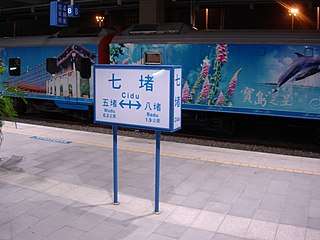
.jpg)
